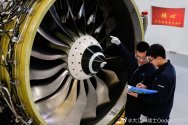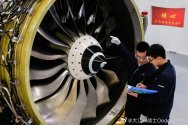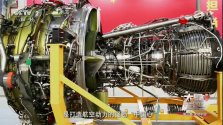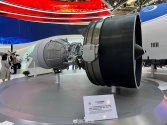The US isn’t *that* ahead.Sorry, in terms of technology I would change this to:
Fighter turbofans:
1: US,
.
.
.
2: UK, France
3: China, Russia
4: Germany, Japan
But guys ... can we stick to the topic, namely "Chinese engines" and leave out any comparatives like quartets game?
You are using an out of date browser. It may not display this or other websites correctly.
You should upgrade or use an alternative browser.
You should upgrade or use an alternative browser.
Chinese Engine Development
- Thread starter jackbh
- Start date
The US isn’t *that* ahead.
Really ... given that today no other country has an engine comparable to the F135 - it seems China and Russia are just reaching the level of the F-119 - and that the next generation 6th generation engine is already running, I'm not sure ... however I won't bet how many "dots (...) they are ahead.
The F-135 is *not* as advanced as you’re making it out to be. Its thrust gain is from using a higher bypass ratio from the same core design as the F119, but with newer materials that allow it to run hotter. In terms of engine generations it’s at best only a half step ahead of the F119, and that’s mainly due to the materials. While the F-135 is an impressive engine from a technology standpoint it is not a revolutionary achievement. Any country with the same materials and basic engine core design capabilities can attain the same performance level if they had a requirement to do so.Really ... given that today no other country has an engine comparable to the F135 - it seems China and Russia are just reaching the level of the F-119 - and that the next generation 6th generation engine is already running, I'm not sure ... however I won't bet how many "dots (...) they are ahead.
We’ll see about the US’s 6th generation engine but anything I could find indicates they’re probably use the same basic approach to the engine core design, just with another step in materials and three cycle first stage fan section for VCE capabilities. There are a lot of innovations in the US’s 6th gen engine approach, but they don’t seem to be with the engine core design itself. And either way we don’t know when those engines emerge out of testing. Meanwhile China’s already started prototyping for their own 6th gen design, and Europe collectively seems to be working on this next leap too, so I’m not sure that the XA100 and XA101 engines are really that much ahead of where other countries are either.
*EDIT: The F-22’s dry thrust is ~110 kN with a bypass ratio of 0.3. The F135’s dry thrust is 120 kN with a bypass ratio of 0.57. In other words the F135’s thrust increase is practically a direct scale increase from the increase in bypass ratio.
Last edited:
Actually, China and Russia have no reached the level of F119 yet. You are being quite generous =)Really ... given that today no other country has an engine comparable to the F135 - it seems China and Russia are just reaching the level of the F-119 - and that the next generation 6th generation engine is already running, I'm not sure ... however I won't bet how many "dots (...) they are ahead.
Even aside from thrust, T/W ratio, Chinese/Russians engines are still behind in fuel burn and maintenance. We will see when WS-15 comes out. Then, China will finally have an engine with a little better T/W ratio than F-119, but still behind F-135. As for the Russians, I think this war with Ukraine just killed any real funding they had for new engine for a while.
Keep in mind that engines are not missiles or electronics. it take a level of precise manufacturing that requires years of continued investment, very high entrance barrier. That's why you see GE, PW and RR continuing to dominate here. What china has done in the past 20 years is already quite extraordinary.
If you take the WS-15 engine core and gave it a larger fan section to attain the same bypass ratio as the F135 you would get comparable total thrust and T:W ratio of the F135. The F135’s thrust capacity is not from big tech leap but rather from a different design emphasis.Actually, China and Russia have no reached the level of F119 yet. You are being quite generous =)
Even aside from thrust, T/W ratio, Chinese/Russians engines are still behind in fuel burn and maintenance. We will see when WS-15 comes out. Then, China will finally have an engine with a little better T/W ratio than F-119, but still behind F-135. As for the Russians, I think this war with Ukraine just killed any real funding they had for new engine for a while.
Keep in mind that engines are not missiles or electronics. it take a level of precise manufacturing that requires years of continued investment, very high entrance barrier. That's why you see GE, PW and RR continuing to dominate here. What china has done in the past 20 years is already quite extraordinary.
keep in mind that the official number of F-119 is classified. The stated dry thrust of F-119 is a lot higher than what you'd expect from an engine of T/W ratio of 9 with A/B. A successful WS-15 project probably only gets you to the same level as a mature F-119 (which would've been probably mid to late 2000s technology for PW). And then also consider how many years it took China to go from WS-10 to WS-10C. We are looking at about 10 years of development for the 16% thrust increase. So yes, even if the tech leap from F-119 to F-135 is not huge (which someone like myself without engine experience can't quantity), increasing T/W by that much while also improving its fuel efficiency can take many years to do.If you take the WS-15 engine core and gave it a larger fan section to attain the same bypass ratio as the F135 you would get comparable total thrust and T:W ratio of the F135. The F135’s thrust capacity is not from big tech leap but rather from a different design emphasis.
Of course, there is the possibility that due to its experience with WS-10, China will be able to go from baseline WS-15 to a higher T/W version in shorter time than with WS-10 project, but we won't know that for a while.
China's first Civil Turbofan engine CJ-1000A will have flight test this year. (BPR - 9.0)I forgot about civilian engines. Should China and Japan even be on that list? AFAIK neither have produced their own domestic engine for civilian aircraft
CJ-2000 (35000 kgf thrust) core machine tested in March 2020. basically development of CJ-2000 is much faster than CJ-1000A.
Attachments
This image has taken before Zhuhai Air Show. Significant source confirmed, during Zhuhai Air show 2021, Authorities confirmed, Fan blades have changed from Titanium alloy to Carbon fiberIf this image is recent that means they really did make the switch from a hollow titanium fan to carbon fiber.
EDIT: nvm looking more carefully at this image it’s pretty clear this is still the titanium fan.




